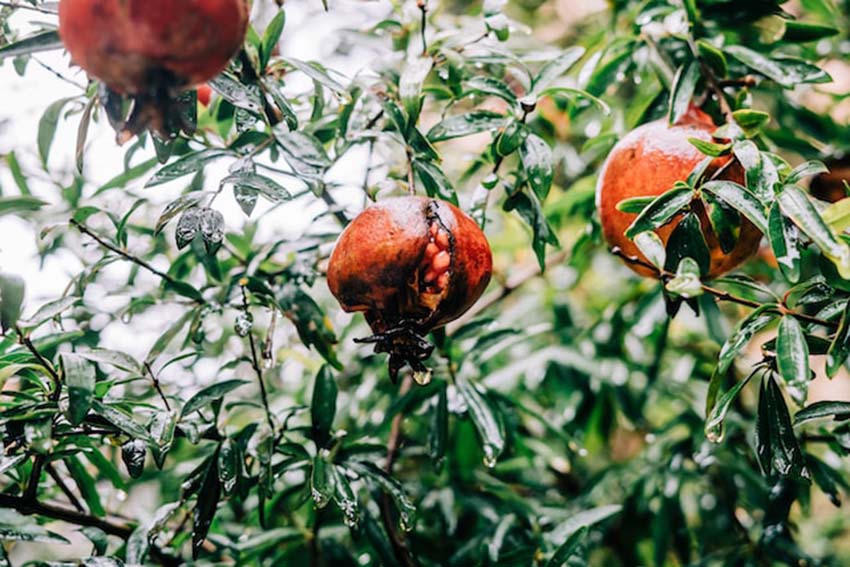
We may receive commissions from purchases made through links in this post, at no additional cost to you.
It’s a frustrating scenario – you watch your pomegranate tree blossom in spring and grow vigorously throughout the summer. Baby fruits start to grow, turn red, and swell to their full size. Then one day you go outside and see the pomegranates cracked, split wide open, or splattered all over the ground.
Unfortunately, pomegranates splitting on the tree is a common problem. So what is going on? What causes pomegranates to split or crack open before they’re ripe? And what on earth can you do to prevent it?
Pomegranates split open because of inconsistent watering, sudden changes in temperature, nutrient deficiencies, or over-ripening on the tree. In many cases, splitting can be prevented through good cultural practices and knowing what signs to look for.
In this article we’ll look at the various causes of cracking pomegranates throughout the growing season, plus what you can do to avoid these issues. If you know what may be causing the splitting problem, you’ll be forearmed to prevent it next season.
Reasons for Pomegranate Fruit Splitting
Any pomegranate variety can be prone to splitting, although thicker-skinned cultivars (such as the popular ‘Wonderful’ pomegranate) may be less likely to have this issue. Also, a cracked pomegranate early in the summer may have a different cause than one you see close to harvest time.
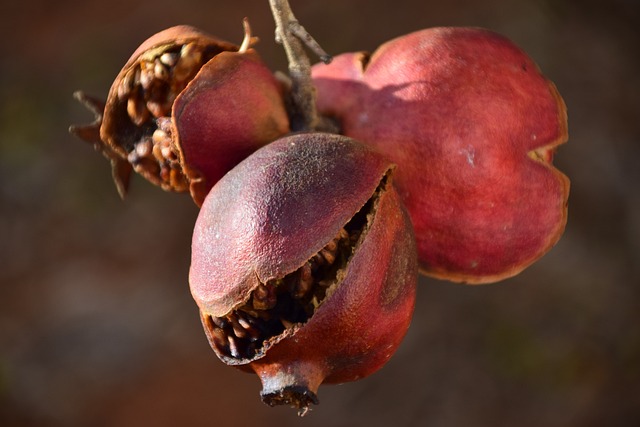
Most pomegranate cracking problems are due to abiotic stresses. Abiotic disorders are those that are not caused by living organisms (fungus, bacterial infection, pests), including over- or under-watering, wind injury, climate, temperature stress, or lack of nutrients.
The following are the most common reasons for pomegranate splitting. Read on to learn exactly what causes each problem and what you can do about it.
1. Irregular Watering
The most likely cause of pomegranate cracking is inconsistent watering, particularly late in the fruiting season. The problem is less about the amount of water a pomegranate tree receives, and more about sudden changes in watering habits
Pomegranate trees are very drought-tolerant, but only to a point. In order to support fruit development, pomegranate trees actually need consistent moisture throughout the season. The tree itself may survive a dry spell, but it will struggle to grow fruit to maturity.
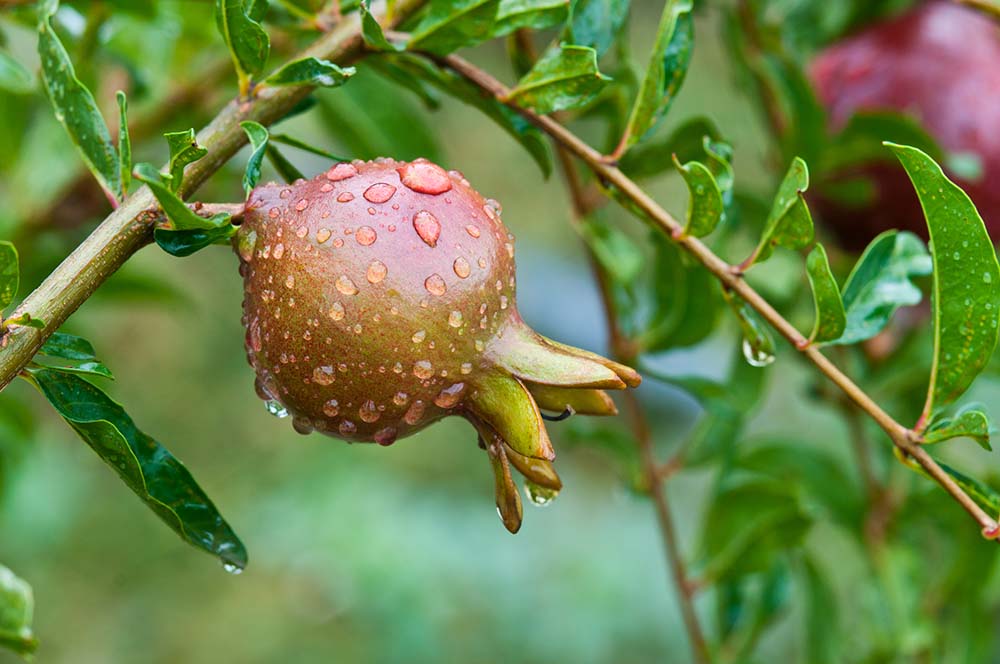
Learn more: Parched Pomegranate Tree? How to Water It Well
If a young pomegranate doesn’t receive enough water as it grows, its rind will harden while it is still small (rather than stay somewhat supple until fully grown). When the tree suddenly gets watered deeply, either by a heavy rainfall or a well-meaning gardener, the tree takes up a lot of water in a short time. The inside of the young fruit starts to expand, cracking the hard skin before it has time to ripen.
This is similar to what happens to tomatoes. Under drought stress, the fruit stops growing, but a sudden storm causes the flesh of the fruit to expand and the skin to split.
Splitting can also happen if the tree receives regular, shallow watering, but the surrounding soil is still dry. It may seem like the tree is getting enough water, but the tree is still under drought conditions. One heavy rainfall, and…cracked pomegranates.
What to Do:
Regularity is key when it comes to watering pomegranate trees. The soil should stay evenly moist, but not saturated. A pomegranate tree needs soil with excellent drainage, otherwise its roots will rot. Water deeply, then allow the top 2 to 3 inches of soil to dry in between waterings.
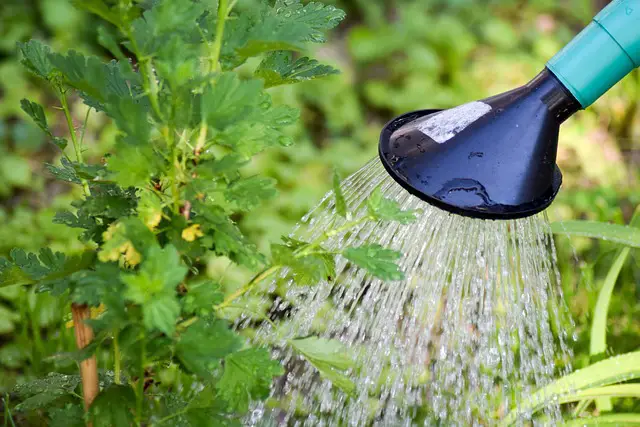
A study conducted in Iran found that watering every 2 weeks resulted in significantly more cracking than watering once per week. If the soil dries out too much between waterings, then the tree will compensate by taking in too much water too quickly.
If it’s been a while since you watered your pomegranate tree and the weather has been dry, be careful not to suddenly give the tree excessive water. Ease into it – start by watering lightly, then increase in amount and frequency over a couple of weeks. There may still be some fruit cracking, but hopefully less than there might have been.
Drip irrigation can help keep watering consistent. As a rule of thumb, use 1-gallon-per-hour emitters. Start with 1-2 emitter for a newly planted pomegranate tree, then increase by 1 emitter every year as it grows. Allow the drip irrigation to run for an hour about once a week (twice in hot weather).
Mulch can help significantly to keep the soil moisture constant and therefore reduce fruit cracking. A 2- to 4-inch layer of mulch keeps the soil cooler, reduces evaporation, and helps the soil underneath retain more moisture.
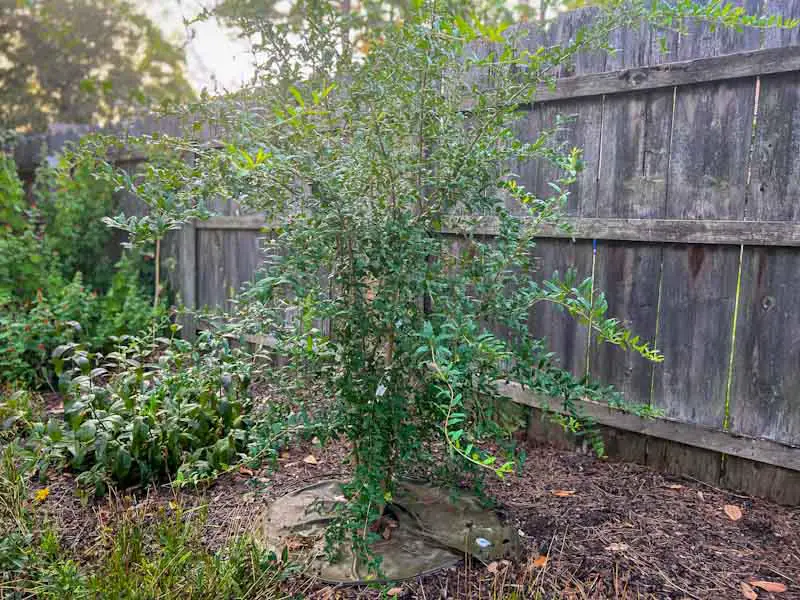
2. Temperature
Temperature fluctuations can be an indirect cause of cracked pomegranates throughout the growing season. The problem isn’t exactly temperature (pomegranate trees love heat), but that temperature affects how the tree absorbs water.
Sudden temperature changes – such as an unseasonable heat wave in the early summer – combined with inconsistent watering is a recipe for pomegranate cracking. It’s a little like what happens when you put a cold baking dish in the oven or microwave. The sudden change from cold to hot causes stress and…crack.
Drastic changes between day and night temperatures can also cause pomegranate splitting. There’s not much you can do about the air temperature, but good watering practices (and mulching) can reduce its impact on the plant.
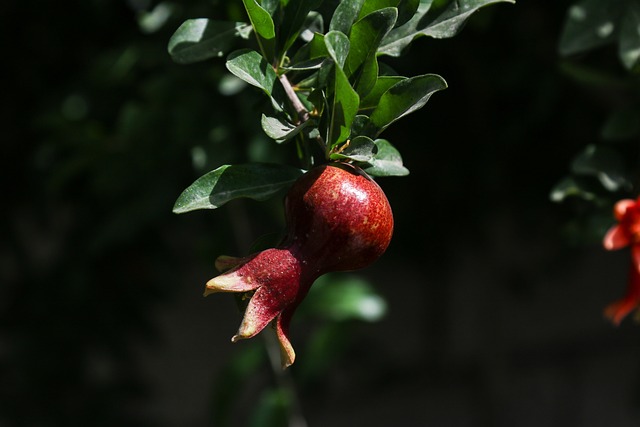
Pomegranate trees have an amazing ability to regulate their own temperature (as do all plants). Just like how we sweat to keep our bodies cool, plants release moisture through their leaves as a cooling mechanism. The hotter the weather, the more water evaporates, so therefore the more water the tree needs.
The same thing happens to the pomegranates themselves. As the surface temperature of the fruit increases, more moisture evaporates from the rind. If there isn’t enough water to replace that moisture loss, the fruit will crack or split open.
What to Do:
If you have a sudden heat wave, or if you live in a climate with extremely hot summers (like me), then water your pomegranate tree more often. Consistent, deep watering will give the tree the moisture it needs to regulate its own temperature.
In general, water a pomegranate tree weekly (up to every 10 days, depending on how much direct sun the plant gets) if the temperatures are over 90°F. If the temperature climbs to the 100s, increase watering to about twice a week.
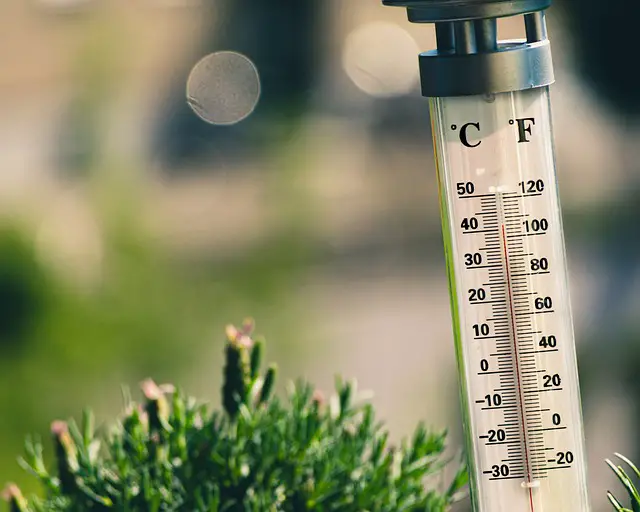
In milder temperatures (in the 70s and 80s) water the tree every 2 to 3 weeks. You may not need to water supplementally at all if there is adequate rainfall.
Most pomegranate trees lose their leaves and go dormant after the fruit is harvested in the fall. Pomegranates are typically deciduous trees unless they are grown in a tropical climate. Dormancy helps the tree protect itself from the cold and conserve energy for the next season’s growth.
Pomegranate trees need little to no watering in the cold winter weather. Most climates get enough winter moisture to forgo watering at all. If the winter is dry, water once per month, at most.
Although I have not tried it, some growers recommend using a kaolin clay spray on pomegranate trees. This organic white clay has ultra fine particles and can protect pomegranate trees from sunburn, splitting, and borer insects. Several studies have been done on its effectiveness, and using kaolin spray has become a regular practice in commercial orchards.
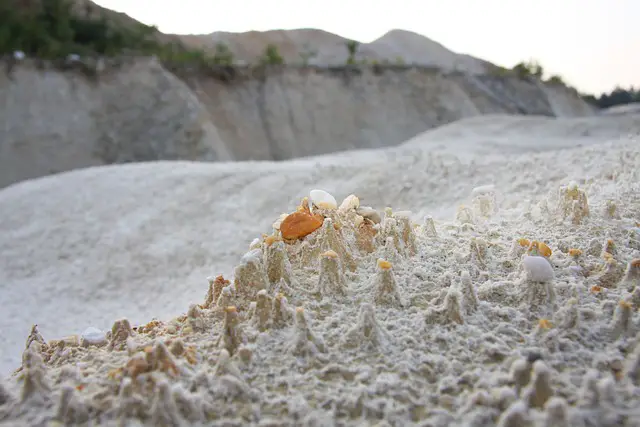
The type of kaolin used for fruit trees is different than cosmetic-grade kaolin clay. Fruit tree kaolin is highly refined, and is copyrighted as “Surround” products (such as this).
Note that the kaolin spray will leave a visible white film all over the tree, if used correctly. This may not be the look you are going for in your garden…but if I were having extensive splitting problems and had ruled out other causes, I would definitely give kaolin a try.
3. Nutrient Deficiencies
Another common culprit for pomegranate splitting is the lack of certain nutrients. In particular, the micronutrients calcium and boron play important roles in how pomegranates develop and whether or not they crack.
There are, of course, other nutrients that are essential for pomegranate fruit development, such as potassium and phosphorus, but they seem to have less of an impact on fruit splitting. Let’s look at how calcium and boron play a part in fruit cracking.
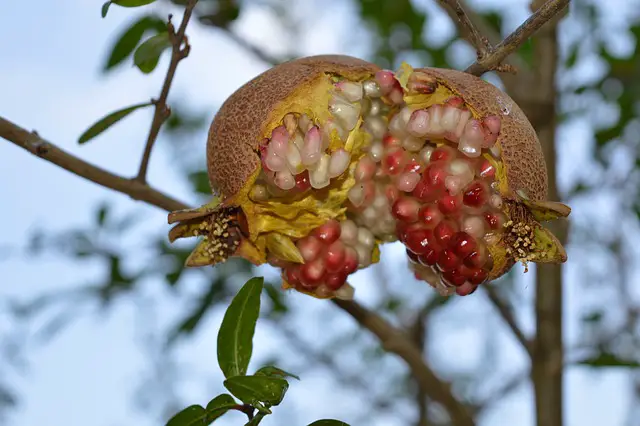
Calcium
Calcium is an important nutrient for pomegranate trees because it improves cell wall strength, cell division, photosynthesis, and overall plant growth. A lack of calcium weakens cell walls in the fruit, which makes the rinds more susceptible to cracking.
A study done in 2017 looked at whether spraying calcium fertilizer on the leaves of a pomegranate tree impacted fruit cracking. It found that a calcium foliar spray twice per season (once at full bloom, then again a month later) led to a significant decrease in fruit splitting. Calcium didn’t have a notable effect on other characteristics such as fruit size or yield.
Boron
Boron is another micronutrient that is essential for healthy pomegranate trees. Like calcium, boron improves the strength of cell walls throughout the plant, which also affects overall root development, pollination, and fruit set, among other things (source).
Related: Perfect Timing: When Does a Pomegranate Tree Bloom and Fruit?
The foliar application of a fertilizer spray containing boric acid (at full bloom and one month after) can significantly reduce pomegranate fruit cracking, as was found in a 2011 study. Boron sprays also increased fruit size, quality, and overall yield.
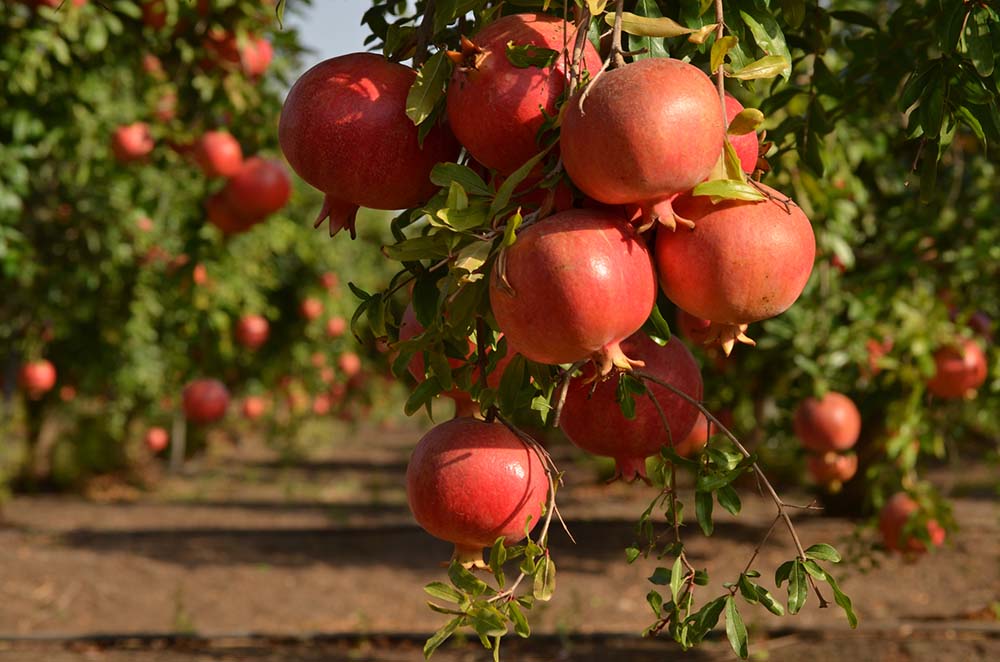
What to Do:
Pomegranate trees generally don’t need much fertilizer, but if you are having problems with fruit cracking, start with soil health. Apply worm castings (vermicompost), well-rotted manure, or other high-quality organic compost around the tree in spring and fall to improve the soil quality. Compost is also a great source of micronutrients such as boron, magnesium, and calcium.
Fertilize pomegranate trees in early spring to support new growth. Choose organic fertilizers that include a good concentration of potassium, plus ingredients like humid acid (which can help with nutrient uptake and water regulation in plants). Most organic fruit tree fertilizers include a balance of macronutrients (the “NPK” numbers on the package – nitrogen, phosphorus, and potassium) and micronutrients.
A great fertilizer option for pomegranates is Jobe’s Organics Fruit and Nut Granular Plant Food. Its 3-5-5 NPK ratio is perfect to support pomegranate development, and it also includes a relatively high percentage of calcium, in addition to other micronutrients.
FoxFarm Happy Frog Fruit and Flower Fertilizer is another brand I trust. It’s derived from all-natural ingredients, and is particularly good for fruit development. It also contains mycorrhizal fungi and humid acid to help with water and nutrient absorption.
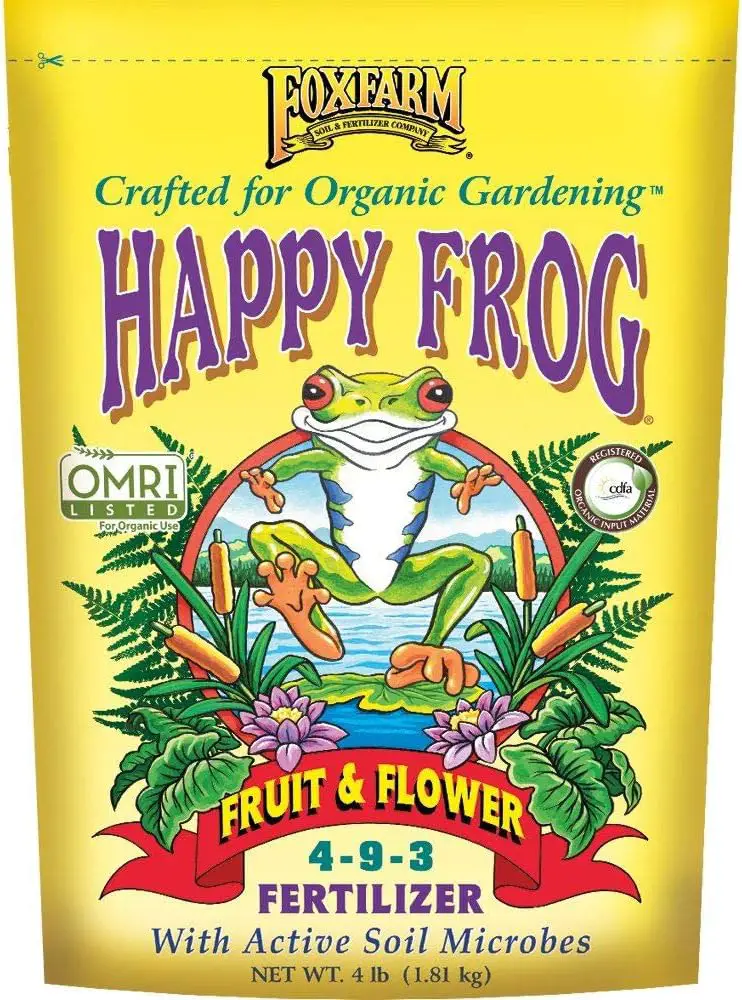
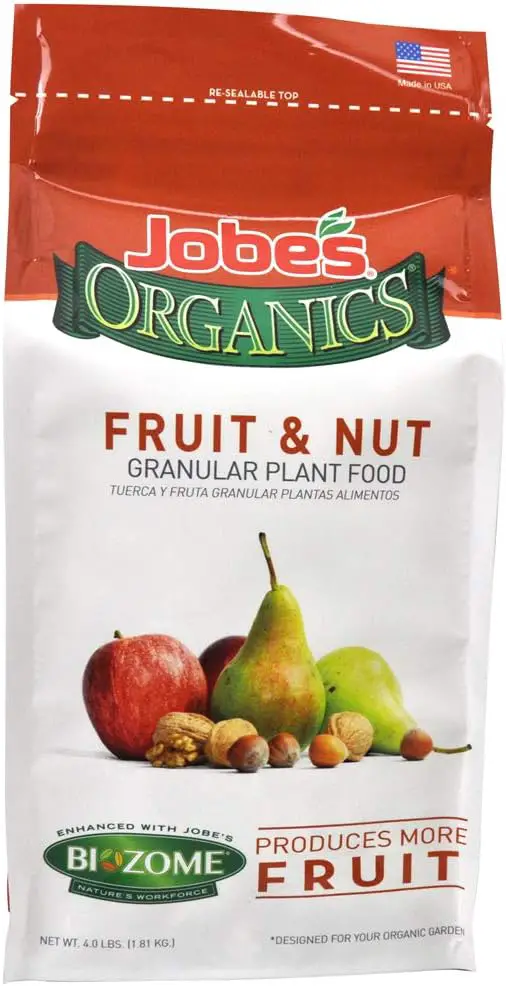
To target the specific calcium and/or boron deficiencies that can lead to fruit cracking, use a foliar spray. Cal-Mag Complete micronutrient fertilizer contains bio-available (able to be immediately used by the plant) calcium, magnesium, iron, boron, manganese, copper, sulfur, and zinc. It also doesn’t include any potentially harmful synthetic agents.
4. Overripeness
Most pomegranates will crack open eventually if they are left on the tree too long. Pomegranates are typically harvested throughout the fall. The longer the fruits are left on the tree, the more likely they are to split and/or fall to the ground.
That is the point of fruiting trees, after all…to propagate the species! Fruits stay on the tree until they rot or fall off, then the seeds germinate and new trees are born. Or, a bird or animal eats the fruit and scatters the seeds to germinate somewhere else.
What to Do:
The best way to prevent overripe pomegranates from splitting is to pick them at the right time. This can be a little tricky with pomegranates, as it’s hard to know when the arils inside are fully formed and juicy.
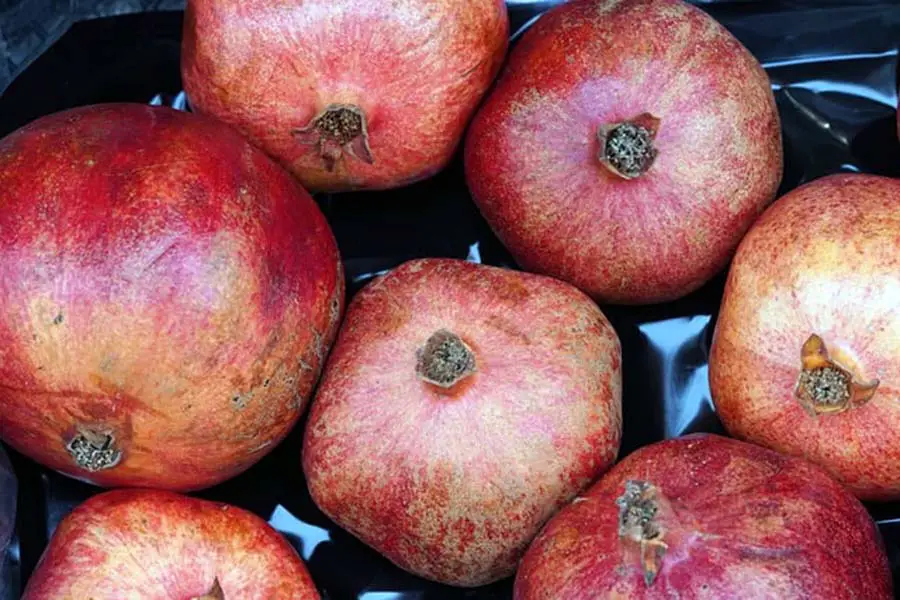
In general, a ripe pomegranate is somewhat square-shaped, heavy for its size, and has leathery, soft skin. Pomegranates stay perfectly round until the inner flesh starts to expand, exerting force on the rind and flattening it out. Underdeveloped pomegranates have smooth, firm, shiny skin, that becomes more matte as the fruit ripens.
For a detailed guide on how to tell when pomegranates are ripe, check out this article: Picking Perfect Pomegranates: How to Know It’s Harvest Time.
Note: Be sure to remove cracked pomegranates from the tree, particularly before winter. Pomegranates that have split open are the perfect site for overwintering pests or fungal disease to take hold.
Do diseases cause pomegranates to split?
Pomegranate fruit splitting is not typically associated with any diseases. Fungal infections are more likely to affect the inside of the fruit without showing any symptoms on the outside.
For example, one of the most common problems for pomegranates is heart rot disease (also called black heart, Alternaria fruit rot, or Aspergillus fruit rot). The only external evidence of this disease may be a slightly lighter coloring or some small brown spots.
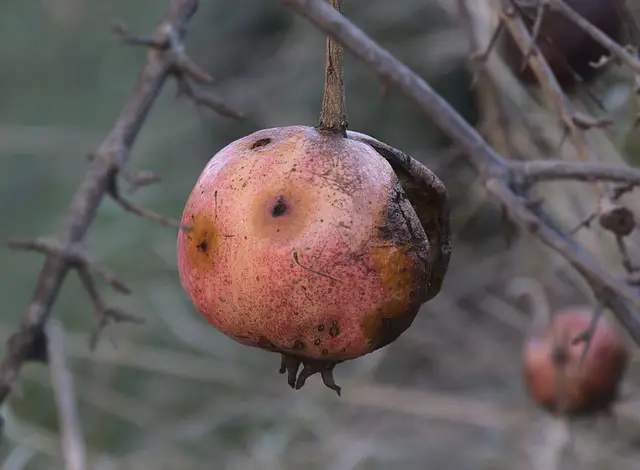
The fruit will be lighter because of internal rotting. But it is not likely to cause fruit cracking since the inside flesh is decaying, rather than expanding. (Find out more information about pomegranate diseases here.)
Can you eat a split pomegranate?
Avoid eating split pomegranates if there is any evidence of under-ripeness rot, discoloration, or pest or animal damage. If the pomegranate is slightly cracked but the pith (white fibrous flesh) is intact, then it may be safe to eat. Do not compost pomegranates that are diseased.
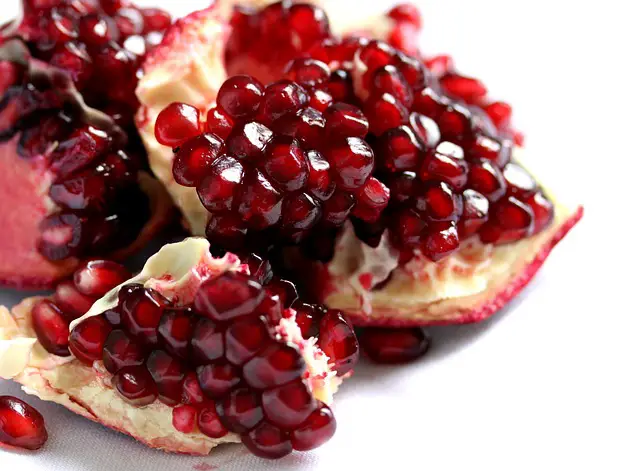
Don’t Eat a Split Pomegranate If…
- …the pomegranate splits open before it is ripe (the arils will look dry and small, the fruit will be small and lightweight).
- …the pomegranate is ripe but the inside looks like its been eaten by insects, birds, or animals.
- …the inside looks rotten or discolored, or if there are soft spots or visible mold.
Consider Eating a Split Pomegranate If…
- …the fruit looks ripe, but undamaged, and hasn’t fallen to the ground (or been covered by bugs).
- …you know the fruit was only recently split and there’s no evidence of disease.
- …the skin is only a little cracked and the pith looks intact.
When in doubt, use your judgment. If you catch it in time, or you know the cracking was simply due to a heavy rainstorm the night before, you’re probably fine. If the fruit looks questionable at all…I would skip it.

